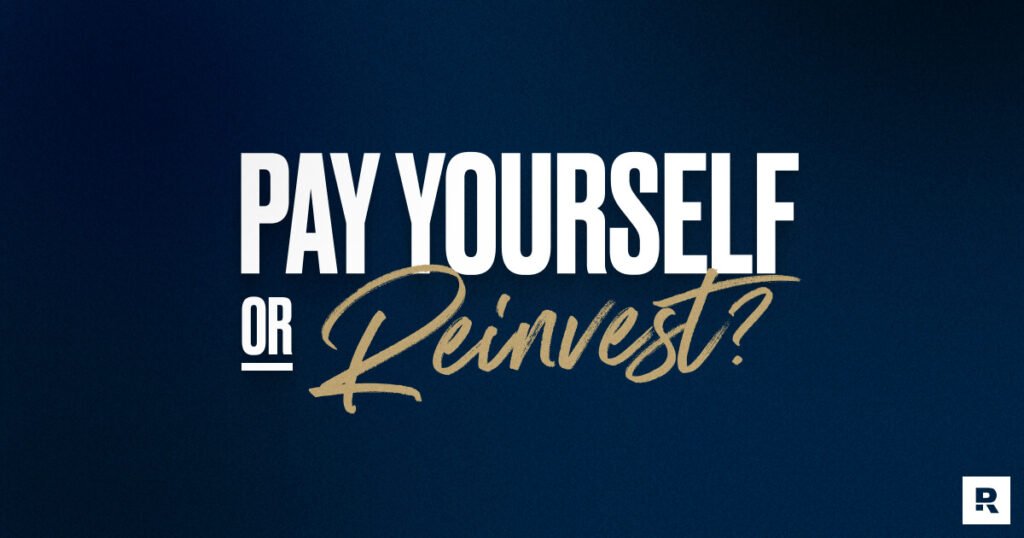Your business is hitting seven figures. The revenue is there. The team is growing. But you’re still not paying yourself what you’re worth—or maybe not at all.
Why not? In most cases, it comes down to one of two things: You’re either unsure when it’s actually okay to take more out of the business, or you’re trying to figure out just how to pay yourself as a business owner . . . responsibly.
Sound familiar? You’re not alone. Thousands of business owners wrestle with how to get over the hump of sacrificing their personal financial goals for the sake of the business. But let’s be honest—you didn’t build this thing just to watch everyone get paid but you. You want to enjoy the reward of everything you’ve built.
So, let’s answer the top questions business owners ask about the best way to pay yourself as a business owner—and how to do it without starving the business.
Top 3 Questions on Paying Yourself as a Business Owner*
1. Should I take a salary from my business?
You should definitely take a salary if your business can support it. The amount you pay yourself and how you pay yourself should grow with the business—not ahead of it.
Start by building a modest living wage into your expenses—just enough to cover your basic household needs while the business grows.
You’re the last line on the spreadsheet when you’re hustling to make payroll, but you still need to be on it.
Today, Dave Ramsey runs a $250 million debt-free company and earns a strong W-2 salary, plus bonuses. But in the early days, he only took enough to cover basic family needs. Once he had a clear idea of his annual profit and made sure everything else was covered, Dave added occasional owner draws on top of his base salary.
And before ever increasing owner compensation, Ramsey Solutions made room in the budget for larger investments in marketing, team culture, profit sharing and health insurance—all designed to grow the company and reward the team.
2. Can I pay myself if I’m still building retained earnings?
If you’re turning a profit but still building retained earnings, you can absolutely pay yourself, but there’s a right way to do it:
If your business is debt-free: Pay yourself a salary based on what it would cost to replace you on payroll. Then, from your profit, put about 50% into retained earnings until you’ve built 3–6 months of operating capital. The rest is yours to take—no guilt or guesswork. Note: As your business grows, hitting six months of retained earnings gets harder—but once you do, you can stop stockpiling.
If you’re paying off business debt: Stick to a living wage for your W-2. Then, set aside 15–20% of even the smallest monthly profits for retained earnings. The rest should go toward paying off debt with intensity. Once that’s clear, shift to building your retained earnings more aggressively, and keep the rest.
Pro tip: Always budget for future expenses, like new equipment and team members, software upgrades and other pricey items. You don’t want those costs to ambush your profit.
3. What’s the best way to pay myself?
The best way to pay yourself depends on your stage of business, cash flow and how your business is set up. Is it an LLC? Corporation? Something else? Your structure, local laws and how you contribute to the business all play a role. Talk to a tax and/or legal pro to make the best call for your setup.
That said, most small-business owners can start with this simple framework:
Set a modest W-2 salary that doesn’t drain your cash flow.
Establish a habit of retained earnings (like the one above).
Take owner draws or bonuses based on actual, realized profit.
If your income is unpredictable, don’t lock in a salary that leaves you sweating bullets in the lean months. It’s better to pay yourself through periodic draws. As your revenue stabilizes, build in that baseline W-2 salary, and schedule additional profit distributions into your business budget.
Paying yourself a consistent W-2 salary helps in three big ways:
It stabilizes your personal finances.
It protects your business from unexpected overdraws.
It forces you to think like a CFO, not just an owner. You’re the financial steward of the company.
Once your budget, retained earnings and reinvestments are in place, you’re not robbing your business to pay yourself. You’re leading with margin and being paid what that leadership is worth.
Reinvesting vs. Paying Yourself—It’s Not Either/Or
You might be thinking, Shouldn’t I just reinvest all my profits?
If you’re still in the early stages of growth or are paying off debt—yes. But not forever. A healthy business does three things:
Reinvests for growth in people, system and tools
Protects the business with retained earnings
Pays the owner based on actual profit—not emotion
It’s not a choice between responsibility and reward. With margin, you get both. You also experience the joy of what we call noble profits.
Profits and the Overflow Principle
Here’s the thing: You’re not selfish for wanting to pay yourself. You’re not wrong for enjoying your success. And you’re not evil for building wealth. But you’re the one who decides what that wealth makes possible.
In Jewish culture, the Havdalah ceremony ends the Sabbath by pouring wine until the cup overflows. The message? You’re meant to produce not just for yourself, but for others.
So build a business with such healthy overflow that you can fill your cup and give generously—without guilt or scarcity.
That’s not just a good business—it’s a noble one.
*Every business is different. Your structure, local laws and role in the company can all impact how and when you pay yourself. Be sure to check with a tax, legal or financial pro to make the best call for your specific situation.

